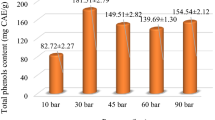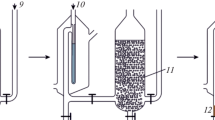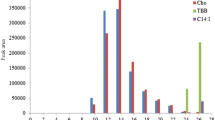Abstract
The solvent extraction technology is a promising method for recovery of unconventional oil resources because of its high efficiency, low energy consumption, and high compatibility. Solvent selection and solvent loss are the main limitations in terms of industrialization of the technology. To evaluate the solvent, efficient detection of the residual solvent content in the extracted-oil gangue is also a problem. A solvent extraction-gas chromatography (GC) combined method is proposed for fast determination of residual organic solvent in extracted-oil ore gangues (mixed with process water). To improve the precision, a combination of the external standard method and the internal standard method (ES&IS method) was applied. This analytical method shows a relative standard deviation (RSD) of less than 2%. The recovery of residual solvent was in the range of 95.4 ~ 102.0 wt% (for a spiked organic solvent content of 0.5 to 25.0 wt%). It is also found that whatever types of solvent (ethanol, tetrahydrofuran, cyclohexane, n-heptane, acetone, ethyl acetate, or toluene) are used, the method detection limit (MDL) can be less than 0.023 mg/mg. The whole procedure of this method, including the pretreatment and instrumental detection, can be finished in-situ in a relatively short time (less than 1.5 hours). On the other hand, due to the simple application of solvent extraction pretreatment and GC detection, this measurement can be a low-cost one. Therefore, it can be applied to solvent selection and solvent recovery method evaluation and propel the industrialization of the solvent extraction technology.
Similar content being viewed by others
References
Feng, L., Stoyanov, S.R., and Xu, Y., Recent Advances in Nonaqueous Extraction of Bitumen from Mineable Oil Sands: A Review, Org. Process Res. Dev., 2017, vol. 21, no. 4, pp. 492–510.
Energy, A., Alberta’s Reserves 2006 and Supply/Demand Outlook 2007-2016, EUB ST98-2007, 2007.
Li, X., Wang, J., He, L., Sui, H., and Yin, W., Ionic Liquid-Assisted Solvent Extraction for Unconventional Oil Recovery: Computational Simulation and Experimental Tests, Energy Fuels, 2016, vol. 30, no. 9, pp. 7074–7081.
Sui, H., Ma, G., He, L., Zhang, Z., and Li, X., Recovery of Heavy Hydrocarbons from Indonesian Carbonate Asphalt Rocks. Part 1: Solvent Extraction, Particle Sedimentation, and Solvent Recycling, Energy Fuels, 2016, vol. 30, no. 11, pp. 9242–9249.
Zhang, Z., Bei, H., Li, H., Li, X., and Gao, X., Understanding the Co-Pyrolysis Behavior of Indonesian Oil Sands and Corn Straw, Energy Fuels, 2017, vol. 31, no. 3, pp. 2538–2547.
Nikakhtari, H., Pal, K., Wolf, S., Choi, P., Liu, Q., and Gray, M.R., Solvent Removal from Cyclohexane-Extracted Oil Sands Gangue, Can. J. Chem. Eng., 2016, vol. 94, no. 3, pp. 408–414.
Pal, K., Nogueira Branco, L.d.P., Heintz, A., Choi, P., Liu, Q., Seidl, P.R., and Gray, M.R., Performance of Solvent Mixtures for Non-Aqueous Extraction of Alberta Oil Sands, Energy Fuels, 2015, vol. 29, no. 4, pp. 2261–2267.
Robbins, G.A., Wang, S., and Stuart, J.D., Using the Static Headspace Method to Determine Henry’s Law Constants, An. Chem., 1993, vol. 65, no. 21, pp. 3113–3118.
MacGillivray, B., Pawliszyn, J., Fowlie, P., and Sagara, C., Headspace Solid-Phase Microextraction Versus Purge and Trap for the Determination of Substituted Benzene Compounds in Water, J. Chromatogr. Sci., 1994, vol. 32, no. 8, pp. 317–322.
Dewulf, J., Van Langenhove, H., and Wittmann, G., Analysis of Volatile Organic Compounds Using Gas Chromatography, TrAC Trends An. Chem., 2002, vol. 21, no. 910, pp. 637–646.
Wu, C.H., Feng, C.T., Lo, Y.S., Lin, T.Y., and Lo, J.G., Determination of Volatile Organic Compounds in Workplace Air by Multisorbent Adsorption/Thermal Desorption-GC/MS, Chemosphere, 2004, vol. 56, no. 1, pp. 71–80.
Cavalcante, R.M., de Andrade, M.V., Marins, R.V., and Oliveira, L.D., Development of a Headspace-Gas Chromatography (HS-GC-PID-FID) Method for the Determination of VOCs in Environmental Aqueous Matrices:Optimization, Verification and Elimination of Matrix Effect and VOC Distribution on the Fortaleza Coast, Brazil, Microchem. J., 2010, vol. 96, no. 2, pp. 337–343.
El-Saeid, M., Al-Wabel, M., Abdel-Nasser, G., Al-Turki, A., and Al-Ghamdi, A., One-Step Extraction of Multiresidue Pesticides in Soil by Microwave-Assisted Extraction Technique, J. Appl. Sci. (Faisalabad), 2010, vol. 10, no. 16, pp. 1775–1780.
De Brabander, H., Noppe, H., Verheyden, K., Bussche, J.V., Wille, K., Okerman, L., Vanhaecke, L., Reybroeck,W., Ooghe, S., and Croubels, S., Residue Analysis: Future Trends from a Historical Perspective, J. Chromatogr. A, 2009, vol. 1216, no. 46, pp. 7964–7976.
James, K.J. and Stack, M.A., Rapid Determination of Volatile Organic Compounds in Environmentally HazardousWastewaters Using Solid PhaseMicroextraction, Fresenius J. An. Chem., 1997, vol. 358, no. 78, pp. 833–837.
Ng, S.J., Sims, N.F., Tay, E.X., and Webster, R.D., Removal of Volatile Organic Compounds (VOCs) from Water Using Mixtures of Olive Oil, Lecithin, and Vitamin E as Phase Transfer Agents, J. Water Process Eng., 2017, vol. 18, pp. 58–64.
Boczkaj, G., Makos, P., and Przyjazny, A., Application of Dynamic Headspace and Gas Chromatography Coupled to Mass Spectrometry (DHS-GC-MS) for the Determination of Oxygenated Volatile Organic Compounds in Refinery Effluents, An. Methods-UK, 2016, vol. 8, no. 17, pp. 3570–3577.
Hu, H., Li, T., Sun, X., Zhang, X., Zhang, X., Zhong, Z., and Guo, Y., Determination of Benzene Series Compounds and Chlorobenzenes in Water Sample by Static Headspace Gas Chromatography with Flame Ionization Detection, J. Sep. Sci., 2015, vol. 38, no. 11, pp. 1916–1923.
Pascale, R., Bianco, G., Calace, S., Masi, S., Mancini, I.M., Mazzone, G., and Caniani, D., Method Development and Optimization for the Determination of Benzene, Toluene, Ethylbenzene and Xylenes in Water at Trace Levels by Static Headspace Extraction Coupled to Gas Chromatography-Barrier Ionization Discharge Detection, J. Chromatogr. A, 2018, vol. 1548, pp. 10–18.
Fredes, A., Sales, C., Barreda, M., Valcarcel, M., Roselló, S., and Beltrán, J., Quantification of Prominent Volatile Compounds Responsible for Muskmelon and Watermelon Aroma by Purge and Trap Extraction Followed by Gas Chromatography-Mass Spectrometry Determination, Food Chem., 2016, vol. 190, pp. 689–700.
Zang, X., Liang, W., Chang, Q., Wu, T., Wang, C., and Wang, Z., Determination of Volatile Organic Compounds in Pen Inks by a Dynamic Headspace Needle Trap Device Combined with Gas Chromatography-Mass Spectrometry, J. Chromatogr. A, 2017, vol. 1513, pp. 27–34.
Kadam, A.A., Karbowiak, T., Voilley, A., and Debeaufort, F., Techniques to Measure Sorption and Migration between Small Molecules and Packaging. A Critical Review, J. Sci. Food. Agr., 2015, vol. 95, no. 7, pp. 1395–1407.
Zhang, Z., Yang, M.J., and Pawliszyn, J., Solid-Phase Microextraction. A Solvent-Free Alternative for Sample Preparation, An. Chem., 1994, vol. 66, no. 17, pp. 844A–853A.
Brokl, M., Bishop, L., Wright, C.G., Liu, C., McAdam, K., and Focant, J.-F., Multivariate Analysis of Mainstream Tobacco Smoke Particulate Phase by Headspace Solid-Phase Micro Extraction Coupled with Comprehensive Two-Dimensional Gas Chromatography-Time-of-Flight Mass Spectrometry, J. Chromatogr. A, 2014, vol. 1370, pp. 216–229.
Park, Y.-S., Dutta, S., Ann, M., Raaijmakers, J.M., and Park, K., Promotion of Plant Growth by Pseudomonas Fluorescens Strain SS101 via Novel Volatile Organic Compounds, Biochem. Bioph. Res. Co., 2015, vol. 461, no. 2, pp. 361–365.
Xiao, Z., Zhou, X., Niu, Y., Yu, D., Zhu, J., and Zhu, G., Optimization and Application of Headspace-Solid-Phase Micro-Extraction Coupled with Gas Chromatography-Mass Spectrometry for the Determination of Volatile Compounds in Cherry Wines, J. Chromatogr., 2015, vol. 978, pp. 122–130.
Wu, J. and Dabros, T., Process for Solvent Extraction of Bitumen fromOil Sand, Energy Fuel., 2012, vol. 26, no. 2, pp. 1002–1008.
Knoll, J.E., Estimation of the Limit of Detection in Chromatography, J. Chromatogr. Sci., 1985, vol. 23, no. 9, pp. 422–425.
Otero, R., Carrera, G., Dulsat, J.F., Fábregas, J.L., and Claramunt, J., Static Headspace Gas Chromatographic Method for Quantitative Determination of Residual Solvents in Pharmaceutical Drug Substances According to European Pharmacopoeia Requirements, J. Chromatogr. A, 2004, vol. 1057, no. 12, pp. 193–201.
Funding
The study was supported by the Municipal Natural Science Foundation of Tianjin (grant no. 18JCQNJC06500). This work partially was performed at Kutateladze Institute of Thermophysics SB RAS with the financial support of the BSI SAS Program for 2017-2020 (project III.18.2.3, reg. no. AAA-17-117030310025-3).
Author information
Authors and Affiliations
Corresponding authors
Rights and permissions
About this article
Cite this article
Li, X., Jia, Z., Wang, J. et al. Detection of Residual Solvent in Solvent-Extracted Unconventional Oil Ore Gangues. J. Engin. Thermophys. 28, 499–506 (2019). https://doi.org/10.1134/S1810232819040052
Received:
Revised:
Accepted:
Published:
Issue Date:
DOI: https://doi.org/10.1134/S1810232819040052




